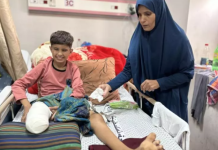The world is rapidly becoming a ‘virtual tinderbox’ of preventable child deaths and child suffering as cases of severe malnutrition rise amid a spiraling global food crisis, UNICEF warns.
Three-year-old Aseel, held by a cousin, underwent treatment for severe acute malnutrition at a UNICEF-supported therapeutic feeding center at Al-Sabeen Hospital in Sana’a, Yemen in June 2021, and is slowly recovering.
Global conditions are ripe for a surge in the number of children with severe wasting, a life-threatening form of malnutrition, as access to lifesaving treatment for the condition comes increasingly under threat, UNICEF warned in a global Child Alert released on May 17.
Soaring food prices, driven by the war in Ukraine and pandemic-fueled budget cuts, are set to drive up both the need for and the cost of therapeutic food.
“Even before the war in Ukraine placed a strain on food security worldwide, conflict, climate shocks and COVID-19 were already wreaking havoc on families’ ability to feed their children,” UNICEF Executive Director Catherine Russell said.
There are a number of global shocks to food security fueling the emergency: war in Ukraine, which has disrupted global food markets; economic strain related to pandemic recovery; and persistent drought conditions in some countries due to climate change.
The number of people facing crisis levels of hunger worldwide has more than doubled from 135 million in December 2019 to 275 million today – with 44 million at risk of famine. Children under age 5 are most likely to suffer from severe malnutrition and can die without treatment.
UNICEF estimates that there are at least 10 million severely wasted children who do not have access to Ready-to-Use Therapeutic Food (RUTF), a nutrient-rich peanut paste and most effective treatment. UNICEF purchases and distributes roughly 80 percent of the world’s supply of RUTF.
The price of RUTF is projected to increase by up to 16 percent over the next six months due to a sharp rise in the cost of raw ingredients, according to UNICEF. This could leave up to 600,000 additional children without access to lifesaving treatment at current spending levels. Shipping and delivery costs are also expected to remain high.
“We can’t end global hunger overnight, but we can stop the most desperate children from dying from severe wasting right now,” Russell said. “Together we can reach every child no matter who they are or where they live with the essential nutrition they need to survive and thrive.”



















